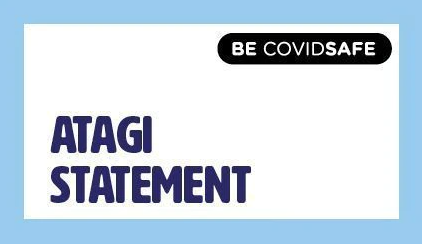
ATAGI met on Wednesday 30 June 2021 to review the latest developments relating to the AstraZeneca COVID-19 vaccine and Thrombosis and Thrombocytopenia Syndrome (TTS) cases in Australia.
ATAGI considered an update from the Therapeutic Goods Administration (TGA) on current confirmed cases and those under investigation. The latest TGA statement on TTS cases, including clinical outcomes, can be found here.
ATAGI examined estimates of risk of TTS by age group in Australia and note that there have been 69 cases of confirmed or probable TTS (41 confirmed cases; 28 probable cases) in around 4.8 million doses of COVID-19 Vaccine AstraZeneca given up to 15 June 2021.
Although estimates of risk based on small numbers of cases are imprecise, the risk of TTS is estimated in Australia at around:
- 2.4 per 100,000 in those
- 1.5 per 100,000 in those ≥60 years.
A breakdown of current rates by decade of age for those aged ≥ 50 years is included here:
| Age bracket (years) | Estimated rate (per 100,000 AZ vaccinations) |
|---|---|
| 2.9 | |
| 50-59 | 2.3 |
| 60-69 | 1.2 |
| 70-79; | 1.7 |
| ≥80 | 2.0 |
ATAGI also noted that the TGA has reviewed Australia's confirmed and probable TTS cases and those reported by overseas regulators using the recently proposed CDC Criteria, which uses the following categories:
- Tier 1: criteria are defined as clots in an unusual location such as the brain or abdomen and a low platelet count with or without a positive test for antibodies that activate platelets (anti-PF4 antibodies);
- Tier 2: criteria are defined as only clots found in more usual locations such as the legs or lungs with a low platelet count and a positive test for anti-PF4 antibodies.
When considering Australian TTS cases in using the recently proposed CDC Criteria, ATAGI noted in the Australian context:
- 25 confirmed and probable TTS cases met the CDC Tier 1 definitions; and
- 18 confirmed and probable TTS cases met the CDC Tier 2 definitions.
- 25 confirmed and probable TTS cases do not meet either CDC Tier 1 or 2 definitions. These include cases with clots in common locations with thrombocytopenia but no evidence of anti-PF4 antibodies, including some with arterial thrombosis. Cases may be reclassified as more clinical data are received.
ATAGI was encouraged by data demonstrating uptake of second doses of COVID-19 Vaccines, including COVID-19 Vaccine AstraZeneca. ATAGI is continuing to closely monitor local and international data on TTS cases and notes risk of TTS following a second dose of COVID-19 Vaccine AstraZeneca is much lower than the risk following a first dose (estimated to be 1.6 per million second doses). ATAGI reinforced the importance of completing a two-dose schedule with AstraZeneca to ensure maximal protection.
ATAGI emphasised that the ATAGI/THANZ joint statement on TTS and the use of the COVID 19 Vaccine AstraZeneca is an important resource. The statement provides updated information about TTS and reaffirms ATAGI's previous advice regarding the safe use of the AstraZeneca COVID-19 Vaccine.
At this time, there is no update to the ATAGI statement from 17 June 2021 in relation to the use of the AstraZeneca COVID-19 vaccine.
ATAGI recommends the COVID-19 Pfizer vaccine (Comirnaty) as the preferred vaccine for those aged 16 to under 60 years. For those aged 60 years and above, the individual benefits of receiving a COVID-19 vaccine are greater than in younger people. The risks of severe outcomes with COVID-19 increase with age and are particularly high in older unvaccinated individuals. The benefit of vaccination in preventing COVID-19 with COVID-19 Vaccine AstraZeneca outweighs the risk of TTS in this age group and underpins its ongoing use in this age group.






